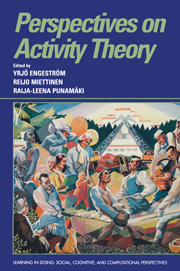Book contents
- Frontmatter
- Contents
- List of contributors
- Series foreword
- Introduction
- Part I Theoretical issues
- Part II Language and its acquisition
- Part III Play, learning, and instruction
- 14 Play and motivation
- 15 Drama games with 6-year-old children: Possibilities and limitations
- 16 Activity formation as an alternative strategy of instruction
- 17 Activity theory and history teaching
- 18 Didactic models and the problem of intertextuality and polyphony
- 19 Metaphor and learning activity
- 20 Transcending traditional school learning: Teachers' work and networks of learning
- Part IV Technology and work
- Part V Therapy and addiction
- Author index
- Subject index
19 - Metaphor and learning activity
Published online by Cambridge University Press: 05 June 2012
- Frontmatter
- Contents
- List of contributors
- Series foreword
- Introduction
- Part I Theoretical issues
- Part II Language and its acquisition
- Part III Play, learning, and instruction
- 14 Play and motivation
- 15 Drama games with 6-year-old children: Possibilities and limitations
- 16 Activity formation as an alternative strategy of instruction
- 17 Activity theory and history teaching
- 18 Didactic models and the problem of intertextuality and polyphony
- 19 Metaphor and learning activity
- 20 Transcending traditional school learning: Teachers' work and networks of learning
- Part IV Technology and work
- Part V Therapy and addiction
- Author index
- Subject index
Summary
Introduction
The novel Ardiente paciencia by the Chilean writer Antonio Skarmeta is actually a novel about metaphors. The plot centers on the story of a friendship between Mario Jimenez, the son of a fisherman in Isla Negra, and the poet Pablo Neruda. Mario, a young man who does seasonal work as a postman, delivers the mail to Neruda daily and always brings his problems along. At the first encounter of the two, a dialogue concerning the question of what a metaphor really is ensues:
Mario placed his hand over his heart in an attempt to control the wild palpitations. He was sure his chest would burst open right there. But he pulled himself together, and with one impertinent finger shaking just inches away from his emeritus client's nose, said, “Do you think that everything in the world, I mean everything, like the wind, the ocean, trees, mountains, fire, animals, houses, deserts, the rain …”
“Now you can say ‘etcetera.’”
“…all the etceteras. Do you think the whole world is a metaphor for something?” Neruda's mouth gaped and his robust chin seemed ready to drop right off his face.
(Skarmeta, 1987, pp. 15–16)Here the metaphor is not a stylistic embellishment of rhetoric. Nor is it an abnormal grammatical expression or phrase. On the contrary, the entire world itself is a metaphor for something. The basis of this view of metaphors is the ability to see something as something else. In this chapter, I concentrate on this ability.
- Type
- Chapter
- Information
- Perspectives on Activity Theory , pp. 314 - 324Publisher: Cambridge University PressPrint publication year: 1999
- 7
- Cited by

